Contract Law 2: Page Law for Surveyors - Assessment 1 Analysis
VerifiedAdded on 2020/05/11
|15
|4552
|86
Report
AI Summary
This report provides an analysis of contract law principles through the examination of several case studies. The first case explores a potential breach of contract, focusing on the elements of offer, acceptance, and consideration, and the implications of counter-offers and the absence of valid acceptance. The second case delves into negligence, the duty of care, and the impact of exclusion clauses, analyzing the application of legal precedents like Donoghue v Stevenson and L'Estrange v Graucob. The report considers the validity of exclusion clauses and potential contributory negligence. The third case touches upon the formalities of contract formation. The analysis examines the legal requirements for contract validity, emphasizing the significance of agreement between parties. This document offers insights into contract law, providing a detailed overview of the principles and their application in various scenarios.

Paraphrase This Document
Need a fresh take? Get an instant paraphrase of this document with our AI Paraphraser
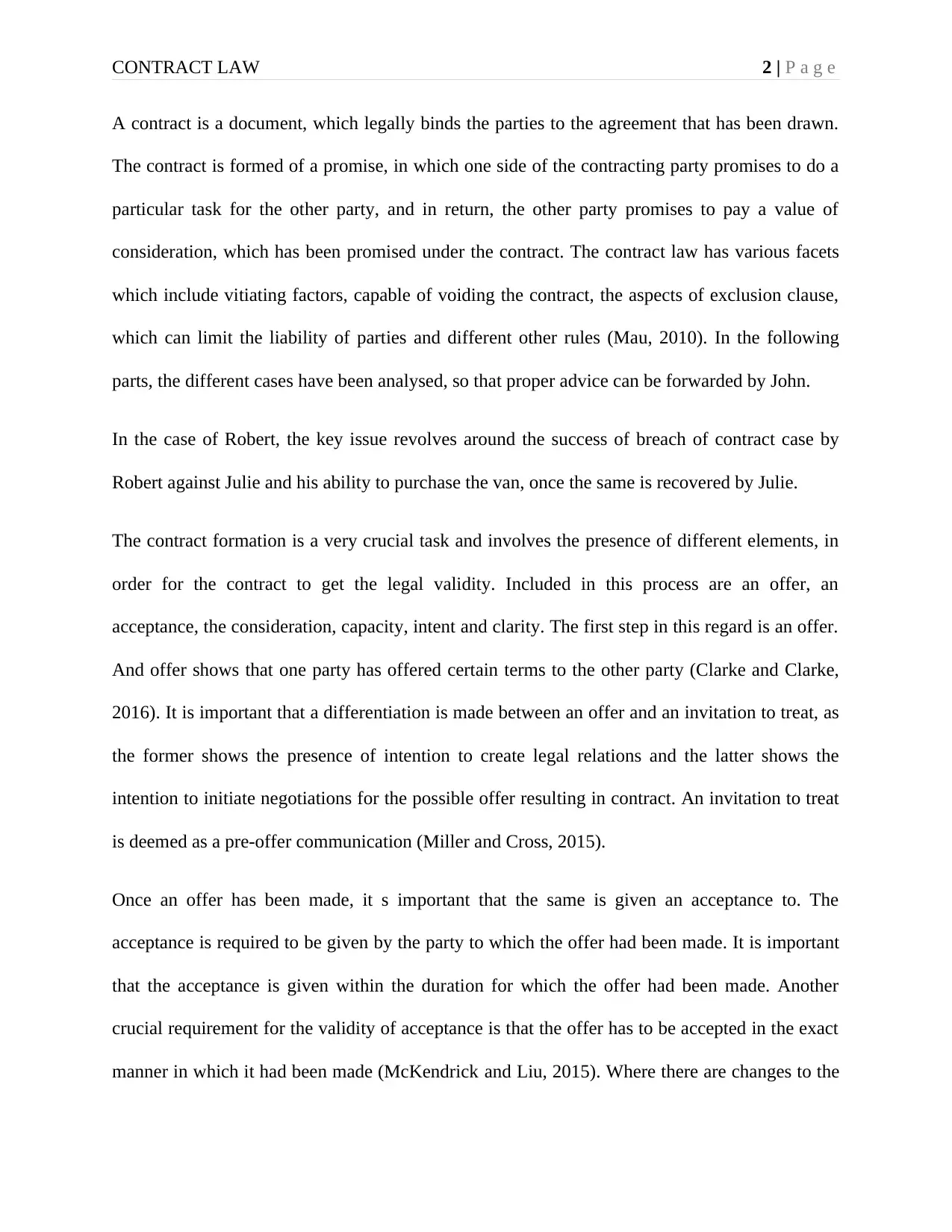
CONTRACT LAW 2 | P a g e
A contract is a document, which legally binds the parties to the agreement that has been drawn.
The contract is formed of a promise, in which one side of the contracting party promises to do a
particular task for the other party, and in return, the other party promises to pay a value of
consideration, which has been promised under the contract. The contract law has various facets
which include vitiating factors, capable of voiding the contract, the aspects of exclusion clause,
which can limit the liability of parties and different other rules (Mau, 2010). In the following
parts, the different cases have been analysed, so that proper advice can be forwarded by John.
In the case of Robert, the key issue revolves around the success of breach of contract case by
Robert against Julie and his ability to purchase the van, once the same is recovered by Julie.
The contract formation is a very crucial task and involves the presence of different elements, in
order for the contract to get the legal validity. Included in this process are an offer, an
acceptance, the consideration, capacity, intent and clarity. The first step in this regard is an offer.
And offer shows that one party has offered certain terms to the other party (Clarke and Clarke,
2016). It is important that a differentiation is made between an offer and an invitation to treat, as
the former shows the presence of intention to create legal relations and the latter shows the
intention to initiate negotiations for the possible offer resulting in contract. An invitation to treat
is deemed as a pre-offer communication (Miller and Cross, 2015).
Once an offer has been made, it s important that the same is given an acceptance to. The
acceptance is required to be given by the party to which the offer had been made. It is important
that the acceptance is given within the duration for which the offer had been made. Another
crucial requirement for the validity of acceptance is that the offer has to be accepted in the exact
manner in which it had been made (McKendrick and Liu, 2015). Where there are changes to the
A contract is a document, which legally binds the parties to the agreement that has been drawn.
The contract is formed of a promise, in which one side of the contracting party promises to do a
particular task for the other party, and in return, the other party promises to pay a value of
consideration, which has been promised under the contract. The contract law has various facets
which include vitiating factors, capable of voiding the contract, the aspects of exclusion clause,
which can limit the liability of parties and different other rules (Mau, 2010). In the following
parts, the different cases have been analysed, so that proper advice can be forwarded by John.
In the case of Robert, the key issue revolves around the success of breach of contract case by
Robert against Julie and his ability to purchase the van, once the same is recovered by Julie.
The contract formation is a very crucial task and involves the presence of different elements, in
order for the contract to get the legal validity. Included in this process are an offer, an
acceptance, the consideration, capacity, intent and clarity. The first step in this regard is an offer.
And offer shows that one party has offered certain terms to the other party (Clarke and Clarke,
2016). It is important that a differentiation is made between an offer and an invitation to treat, as
the former shows the presence of intention to create legal relations and the latter shows the
intention to initiate negotiations for the possible offer resulting in contract. An invitation to treat
is deemed as a pre-offer communication (Miller and Cross, 2015).
Once an offer has been made, it s important that the same is given an acceptance to. The
acceptance is required to be given by the party to which the offer had been made. It is important
that the acceptance is given within the duration for which the offer had been made. Another
crucial requirement for the validity of acceptance is that the offer has to be accepted in the exact
manner in which it had been made (McKendrick and Liu, 2015). Where there are changes to the
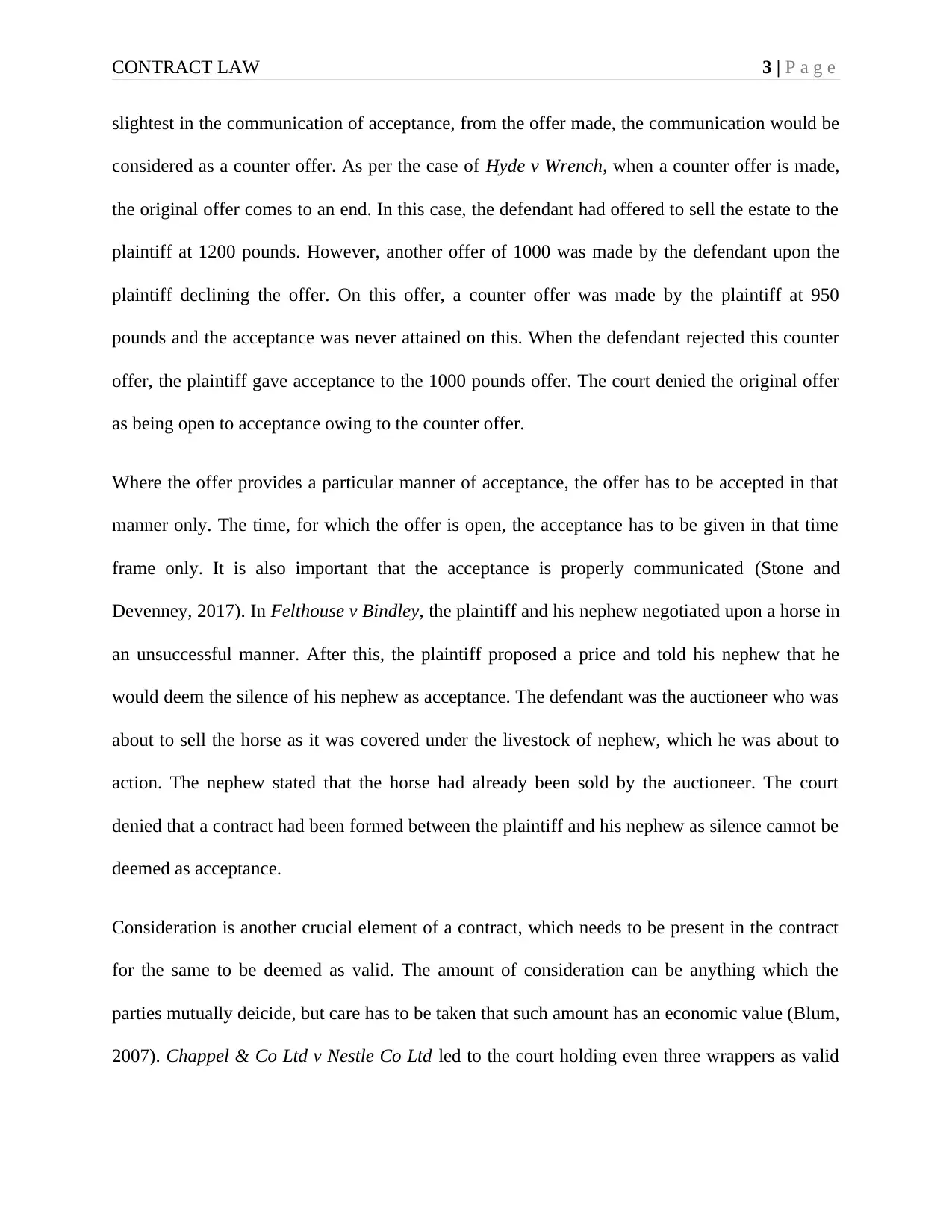
CONTRACT LAW 3 | P a g e
slightest in the communication of acceptance, from the offer made, the communication would be
considered as a counter offer. As per the case of Hyde v Wrench, when a counter offer is made,
the original offer comes to an end. In this case, the defendant had offered to sell the estate to the
plaintiff at 1200 pounds. However, another offer of 1000 was made by the defendant upon the
plaintiff declining the offer. On this offer, a counter offer was made by the plaintiff at 950
pounds and the acceptance was never attained on this. When the defendant rejected this counter
offer, the plaintiff gave acceptance to the 1000 pounds offer. The court denied the original offer
as being open to acceptance owing to the counter offer.
Where the offer provides a particular manner of acceptance, the offer has to be accepted in that
manner only. The time, for which the offer is open, the acceptance has to be given in that time
frame only. It is also important that the acceptance is properly communicated (Stone and
Devenney, 2017). In Felthouse v Bindley, the plaintiff and his nephew negotiated upon a horse in
an unsuccessful manner. After this, the plaintiff proposed a price and told his nephew that he
would deem the silence of his nephew as acceptance. The defendant was the auctioneer who was
about to sell the horse as it was covered under the livestock of nephew, which he was about to
action. The nephew stated that the horse had already been sold by the auctioneer. The court
denied that a contract had been formed between the plaintiff and his nephew as silence cannot be
deemed as acceptance.
Consideration is another crucial element of a contract, which needs to be present in the contract
for the same to be deemed as valid. The amount of consideration can be anything which the
parties mutually deicide, but care has to be taken that such amount has an economic value (Blum,
2007). Chappel & Co Ltd v Nestle Co Ltd led to the court holding even three wrappers as valid
slightest in the communication of acceptance, from the offer made, the communication would be
considered as a counter offer. As per the case of Hyde v Wrench, when a counter offer is made,
the original offer comes to an end. In this case, the defendant had offered to sell the estate to the
plaintiff at 1200 pounds. However, another offer of 1000 was made by the defendant upon the
plaintiff declining the offer. On this offer, a counter offer was made by the plaintiff at 950
pounds and the acceptance was never attained on this. When the defendant rejected this counter
offer, the plaintiff gave acceptance to the 1000 pounds offer. The court denied the original offer
as being open to acceptance owing to the counter offer.
Where the offer provides a particular manner of acceptance, the offer has to be accepted in that
manner only. The time, for which the offer is open, the acceptance has to be given in that time
frame only. It is also important that the acceptance is properly communicated (Stone and
Devenney, 2017). In Felthouse v Bindley, the plaintiff and his nephew negotiated upon a horse in
an unsuccessful manner. After this, the plaintiff proposed a price and told his nephew that he
would deem the silence of his nephew as acceptance. The defendant was the auctioneer who was
about to sell the horse as it was covered under the livestock of nephew, which he was about to
action. The nephew stated that the horse had already been sold by the auctioneer. The court
denied that a contract had been formed between the plaintiff and his nephew as silence cannot be
deemed as acceptance.
Consideration is another crucial element of a contract, which needs to be present in the contract
for the same to be deemed as valid. The amount of consideration can be anything which the
parties mutually deicide, but care has to be taken that such amount has an economic value (Blum,
2007). Chappel & Co Ltd v Nestle Co Ltd led to the court holding even three wrappers as valid
⊘ This is a preview!⊘
Do you want full access?
Subscribe today to unlock all pages.

Trusted by 1+ million students worldwide
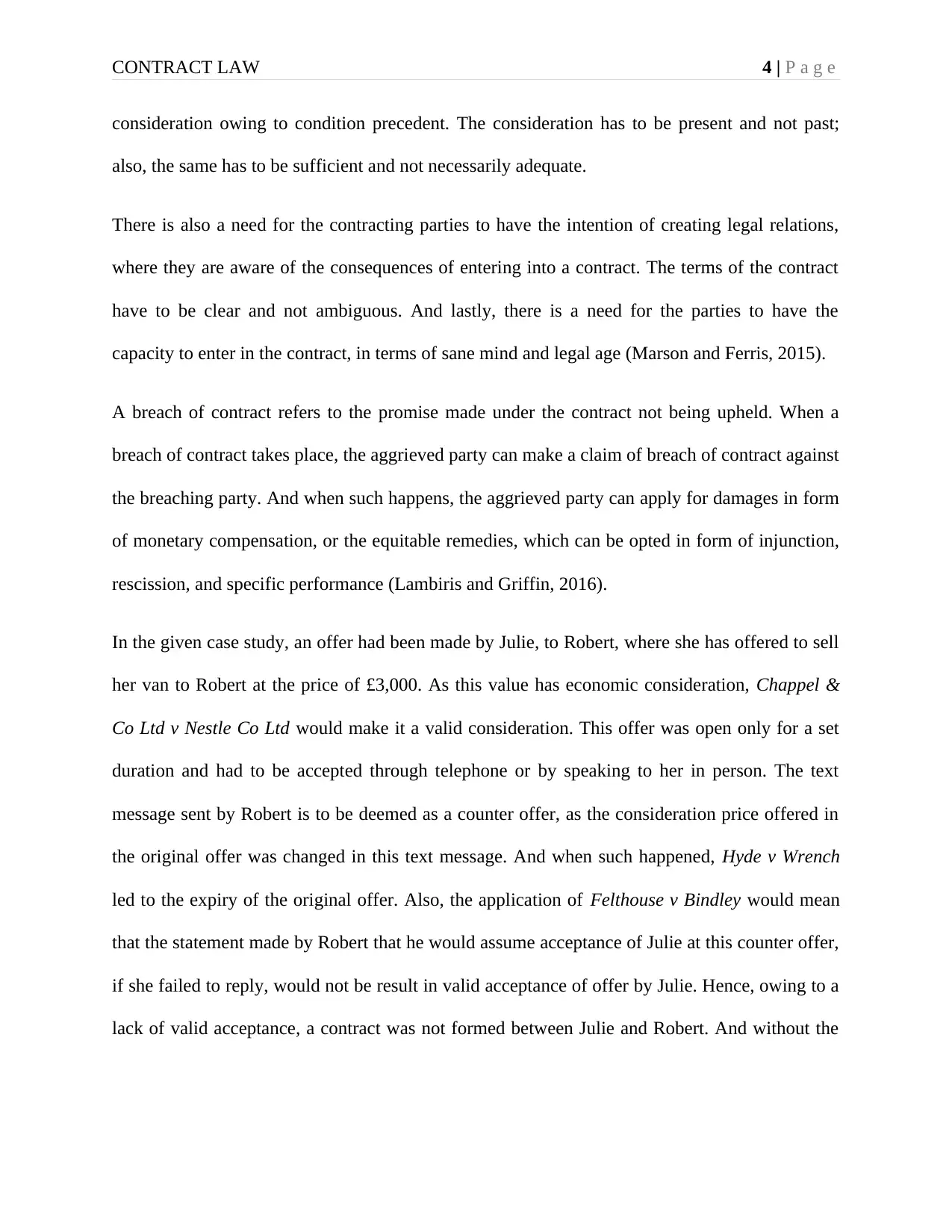
CONTRACT LAW 4 | P a g e
consideration owing to condition precedent. The consideration has to be present and not past;
also, the same has to be sufficient and not necessarily adequate.
There is also a need for the contracting parties to have the intention of creating legal relations,
where they are aware of the consequences of entering into a contract. The terms of the contract
have to be clear and not ambiguous. And lastly, there is a need for the parties to have the
capacity to enter in the contract, in terms of sane mind and legal age (Marson and Ferris, 2015).
A breach of contract refers to the promise made under the contract not being upheld. When a
breach of contract takes place, the aggrieved party can make a claim of breach of contract against
the breaching party. And when such happens, the aggrieved party can apply for damages in form
of monetary compensation, or the equitable remedies, which can be opted in form of injunction,
rescission, and specific performance (Lambiris and Griffin, 2016).
In the given case study, an offer had been made by Julie, to Robert, where she has offered to sell
her van to Robert at the price of £3,000. As this value has economic consideration, Chappel &
Co Ltd v Nestle Co Ltd would make it a valid consideration. This offer was open only for a set
duration and had to be accepted through telephone or by speaking to her in person. The text
message sent by Robert is to be deemed as a counter offer, as the consideration price offered in
the original offer was changed in this text message. And when such happened, Hyde v Wrench
led to the expiry of the original offer. Also, the application of Felthouse v Bindley would mean
that the statement made by Robert that he would assume acceptance of Julie at this counter offer,
if she failed to reply, would not be result in valid acceptance of offer by Julie. Hence, owing to a
lack of valid acceptance, a contract was not formed between Julie and Robert. And without the
consideration owing to condition precedent. The consideration has to be present and not past;
also, the same has to be sufficient and not necessarily adequate.
There is also a need for the contracting parties to have the intention of creating legal relations,
where they are aware of the consequences of entering into a contract. The terms of the contract
have to be clear and not ambiguous. And lastly, there is a need for the parties to have the
capacity to enter in the contract, in terms of sane mind and legal age (Marson and Ferris, 2015).
A breach of contract refers to the promise made under the contract not being upheld. When a
breach of contract takes place, the aggrieved party can make a claim of breach of contract against
the breaching party. And when such happens, the aggrieved party can apply for damages in form
of monetary compensation, or the equitable remedies, which can be opted in form of injunction,
rescission, and specific performance (Lambiris and Griffin, 2016).
In the given case study, an offer had been made by Julie, to Robert, where she has offered to sell
her van to Robert at the price of £3,000. As this value has economic consideration, Chappel &
Co Ltd v Nestle Co Ltd would make it a valid consideration. This offer was open only for a set
duration and had to be accepted through telephone or by speaking to her in person. The text
message sent by Robert is to be deemed as a counter offer, as the consideration price offered in
the original offer was changed in this text message. And when such happened, Hyde v Wrench
led to the expiry of the original offer. Also, the application of Felthouse v Bindley would mean
that the statement made by Robert that he would assume acceptance of Julie at this counter offer,
if she failed to reply, would not be result in valid acceptance of offer by Julie. Hence, owing to a
lack of valid acceptance, a contract was not formed between Julie and Robert. And without the
Paraphrase This Document
Need a fresh take? Get an instant paraphrase of this document with our AI Paraphraser

CONTRACT LAW 5 | P a g e
presence of a contract, a breach of contract cannot be successfully claimed upon by Robert. As a
result of this, Julie is not required to recover the van, in order for the same to be sold to Robert.
The next case is that of Sandra and the key issue of this case is the ability of Sandra to
successfully sue Bob’s Builders for negligence and the impact of the exclusion clause on her
case.
Negligence is covered under the tort law and is deemed as a breach of duty of care which one
person owed to another person. When a person undertakes a task, which has the capacity of
hurting another person, a duty is owed by such person to the other person to undertaken this task
in a careful manner, so that the other person does not bear any injury or harm (Greene, 2013).
When this duty is not upheld, it results in the breach, giving rise to a case of negligence, whereby
the aggrieved party can apply for damages. However, these damages can be reduced where it is
proved that the plaintiff contributed towards their injury, resulting in contributory negligence
(Turner, 2013).
The manufacturers owe a duty of care to their consumers and this can be established with the
help of the leading case of Donoghue v Stevenson. In this case, the plaintiff had consumed the
concoction from the ginger beer bottle manufactured by the defendant. In this bottle, was a dead
snail, which led to the illness of the plaintiff and she raised a claim of negligence against the
manufacturer. It was claimed by the defendant that a duty of care was not owed in this case as
the plaintiff had not purchased the bottle directly, but had been purchased by the friend of
plaintiff. However, the court held that there was proximity between a consumer and a
manufacturer which gave rise to a duty of care and that there was reasonable foreseeability of a
contaminated bottle resulting in injury to the consumer. And so, upholding the presence of duty
presence of a contract, a breach of contract cannot be successfully claimed upon by Robert. As a
result of this, Julie is not required to recover the van, in order for the same to be sold to Robert.
The next case is that of Sandra and the key issue of this case is the ability of Sandra to
successfully sue Bob’s Builders for negligence and the impact of the exclusion clause on her
case.
Negligence is covered under the tort law and is deemed as a breach of duty of care which one
person owed to another person. When a person undertakes a task, which has the capacity of
hurting another person, a duty is owed by such person to the other person to undertaken this task
in a careful manner, so that the other person does not bear any injury or harm (Greene, 2013).
When this duty is not upheld, it results in the breach, giving rise to a case of negligence, whereby
the aggrieved party can apply for damages. However, these damages can be reduced where it is
proved that the plaintiff contributed towards their injury, resulting in contributory negligence
(Turner, 2013).
The manufacturers owe a duty of care to their consumers and this can be established with the
help of the leading case of Donoghue v Stevenson. In this case, the plaintiff had consumed the
concoction from the ginger beer bottle manufactured by the defendant. In this bottle, was a dead
snail, which led to the illness of the plaintiff and she raised a claim of negligence against the
manufacturer. It was claimed by the defendant that a duty of care was not owed in this case as
the plaintiff had not purchased the bottle directly, but had been purchased by the friend of
plaintiff. However, the court held that there was proximity between a consumer and a
manufacturer which gave rise to a duty of care and that there was reasonable foreseeability of a
contaminated bottle resulting in injury to the consumer. And so, upholding the presence of duty
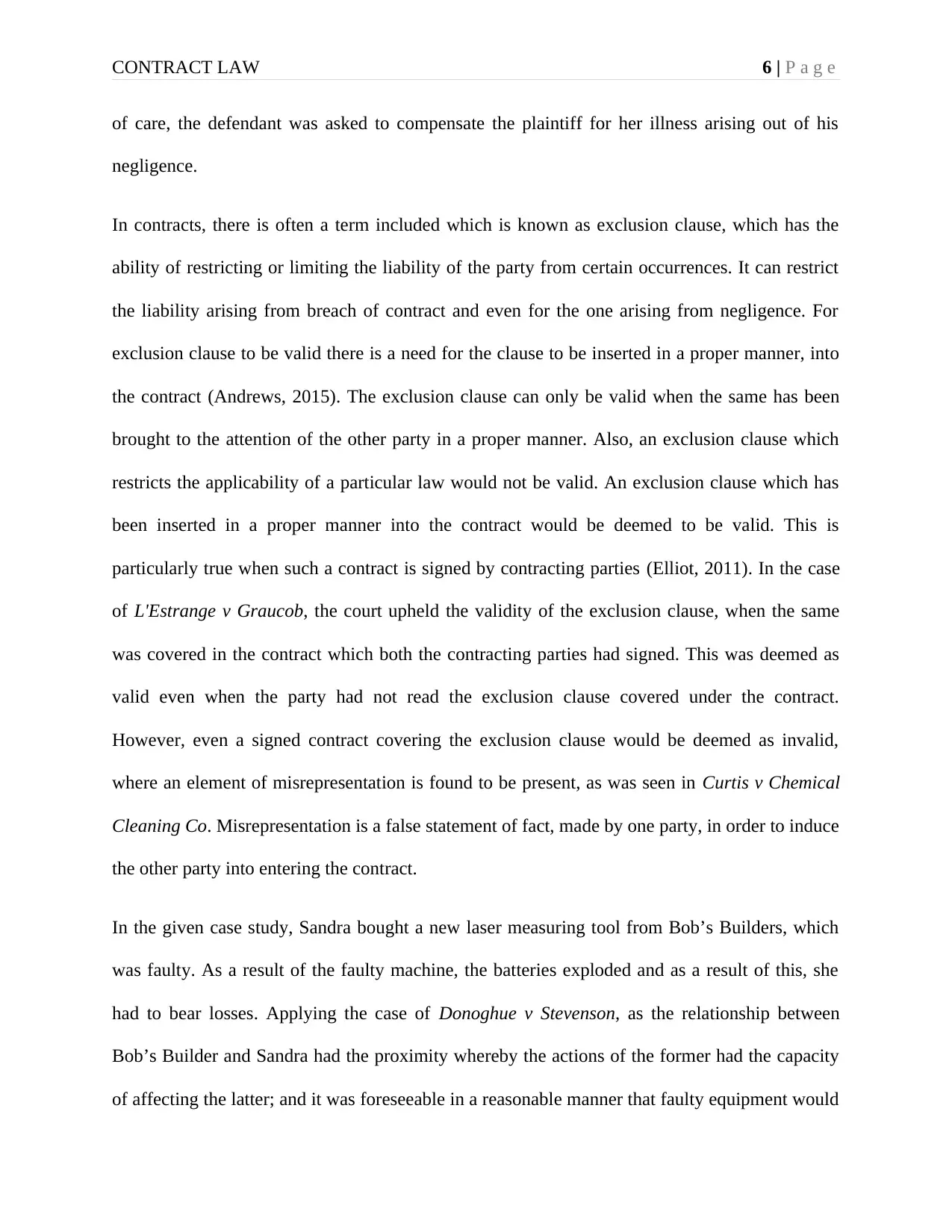
CONTRACT LAW 6 | P a g e
of care, the defendant was asked to compensate the plaintiff for her illness arising out of his
negligence.
In contracts, there is often a term included which is known as exclusion clause, which has the
ability of restricting or limiting the liability of the party from certain occurrences. It can restrict
the liability arising from breach of contract and even for the one arising from negligence. For
exclusion clause to be valid there is a need for the clause to be inserted in a proper manner, into
the contract (Andrews, 2015). The exclusion clause can only be valid when the same has been
brought to the attention of the other party in a proper manner. Also, an exclusion clause which
restricts the applicability of a particular law would not be valid. An exclusion clause which has
been inserted in a proper manner into the contract would be deemed to be valid. This is
particularly true when such a contract is signed by contracting parties (Elliot, 2011). In the case
of L'Estrange v Graucob, the court upheld the validity of the exclusion clause, when the same
was covered in the contract which both the contracting parties had signed. This was deemed as
valid even when the party had not read the exclusion clause covered under the contract.
However, even a signed contract covering the exclusion clause would be deemed as invalid,
where an element of misrepresentation is found to be present, as was seen in Curtis v Chemical
Cleaning Co. Misrepresentation is a false statement of fact, made by one party, in order to induce
the other party into entering the contract.
In the given case study, Sandra bought a new laser measuring tool from Bob’s Builders, which
was faulty. As a result of the faulty machine, the batteries exploded and as a result of this, she
had to bear losses. Applying the case of Donoghue v Stevenson, as the relationship between
Bob’s Builder and Sandra had the proximity whereby the actions of the former had the capacity
of affecting the latter; and it was foreseeable in a reasonable manner that faulty equipment would
of care, the defendant was asked to compensate the plaintiff for her illness arising out of his
negligence.
In contracts, there is often a term included which is known as exclusion clause, which has the
ability of restricting or limiting the liability of the party from certain occurrences. It can restrict
the liability arising from breach of contract and even for the one arising from negligence. For
exclusion clause to be valid there is a need for the clause to be inserted in a proper manner, into
the contract (Andrews, 2015). The exclusion clause can only be valid when the same has been
brought to the attention of the other party in a proper manner. Also, an exclusion clause which
restricts the applicability of a particular law would not be valid. An exclusion clause which has
been inserted in a proper manner into the contract would be deemed to be valid. This is
particularly true when such a contract is signed by contracting parties (Elliot, 2011). In the case
of L'Estrange v Graucob, the court upheld the validity of the exclusion clause, when the same
was covered in the contract which both the contracting parties had signed. This was deemed as
valid even when the party had not read the exclusion clause covered under the contract.
However, even a signed contract covering the exclusion clause would be deemed as invalid,
where an element of misrepresentation is found to be present, as was seen in Curtis v Chemical
Cleaning Co. Misrepresentation is a false statement of fact, made by one party, in order to induce
the other party into entering the contract.
In the given case study, Sandra bought a new laser measuring tool from Bob’s Builders, which
was faulty. As a result of the faulty machine, the batteries exploded and as a result of this, she
had to bear losses. Applying the case of Donoghue v Stevenson, as the relationship between
Bob’s Builder and Sandra had the proximity whereby the actions of the former had the capacity
of affecting the latter; and it was foreseeable in a reasonable manner that faulty equipment would
⊘ This is a preview!⊘
Do you want full access?
Subscribe today to unlock all pages.

Trusted by 1+ million students worldwide

CONTRACT LAW 7 | P a g e
cause damage a case of negligence would be successful by Sandra. However, Bob’s Builders can
claim the contributory negligence of Sandra as she continued to use the machine even after she
could smell something burning.
Also, there is a need to check the validity of the exclusion clause before the damages are
awarded to Sandra. This clause had been inserted in the contract, which had been signed by the
parties. As per L'Estrange v Graucob, this clause would be valid, even when Sandra had not read
it. However, if she can show that the contract was misrepresented as ‘standard terms’, instead of
just her forming such a view, she can get the exclusion clause to be proved as invalid. Till that is
done, the exclusion clause would be deemed as valid, as a result of which, a case of negligence
would not result in liability of Bob’s Builders, owing to the validity of exclusion clause.
The third case is that of Ahmed regarding the formality of signing the contract for the same to be
valid and regarding the same to be applicable on the transfer deed.
The English law dictates that a written signature is not a necessary condition in order for a
contract to be deemed as a valid one. The contracts are deemed as valid one where the parties to
the contract reach an agreement and this can be done in an oral manner, in an electronic manner
or in a physical paper document (Ayres and Klass, 2012). In the case of Golden Ocean Group
Ltd v Salgaocar Mining Industries Pvt Ltd, the court held that a contract cannot be denied with
regards to its enforceability where the same has been concluded in an electronic manner. There
are certain cases where the electronic signatures are not deemed as valid, particularly when they
cover explicit requirements, for instance formal notarial process or handwritten signatures. The
transfer deed is one of such documents which require handwritten signatures and these real
cause damage a case of negligence would be successful by Sandra. However, Bob’s Builders can
claim the contributory negligence of Sandra as she continued to use the machine even after she
could smell something burning.
Also, there is a need to check the validity of the exclusion clause before the damages are
awarded to Sandra. This clause had been inserted in the contract, which had been signed by the
parties. As per L'Estrange v Graucob, this clause would be valid, even when Sandra had not read
it. However, if she can show that the contract was misrepresented as ‘standard terms’, instead of
just her forming such a view, she can get the exclusion clause to be proved as invalid. Till that is
done, the exclusion clause would be deemed as valid, as a result of which, a case of negligence
would not result in liability of Bob’s Builders, owing to the validity of exclusion clause.
The third case is that of Ahmed regarding the formality of signing the contract for the same to be
valid and regarding the same to be applicable on the transfer deed.
The English law dictates that a written signature is not a necessary condition in order for a
contract to be deemed as a valid one. The contracts are deemed as valid one where the parties to
the contract reach an agreement and this can be done in an oral manner, in an electronic manner
or in a physical paper document (Ayres and Klass, 2012). In the case of Golden Ocean Group
Ltd v Salgaocar Mining Industries Pvt Ltd, the court held that a contract cannot be denied with
regards to its enforceability where the same has been concluded in an electronic manner. There
are certain cases where the electronic signatures are not deemed as valid, particularly when they
cover explicit requirements, for instance formal notarial process or handwritten signatures. The
transfer deed is one of such documents which require handwritten signatures and these real
Paraphrase This Document
Need a fresh take? Get an instant paraphrase of this document with our AI Paraphraser
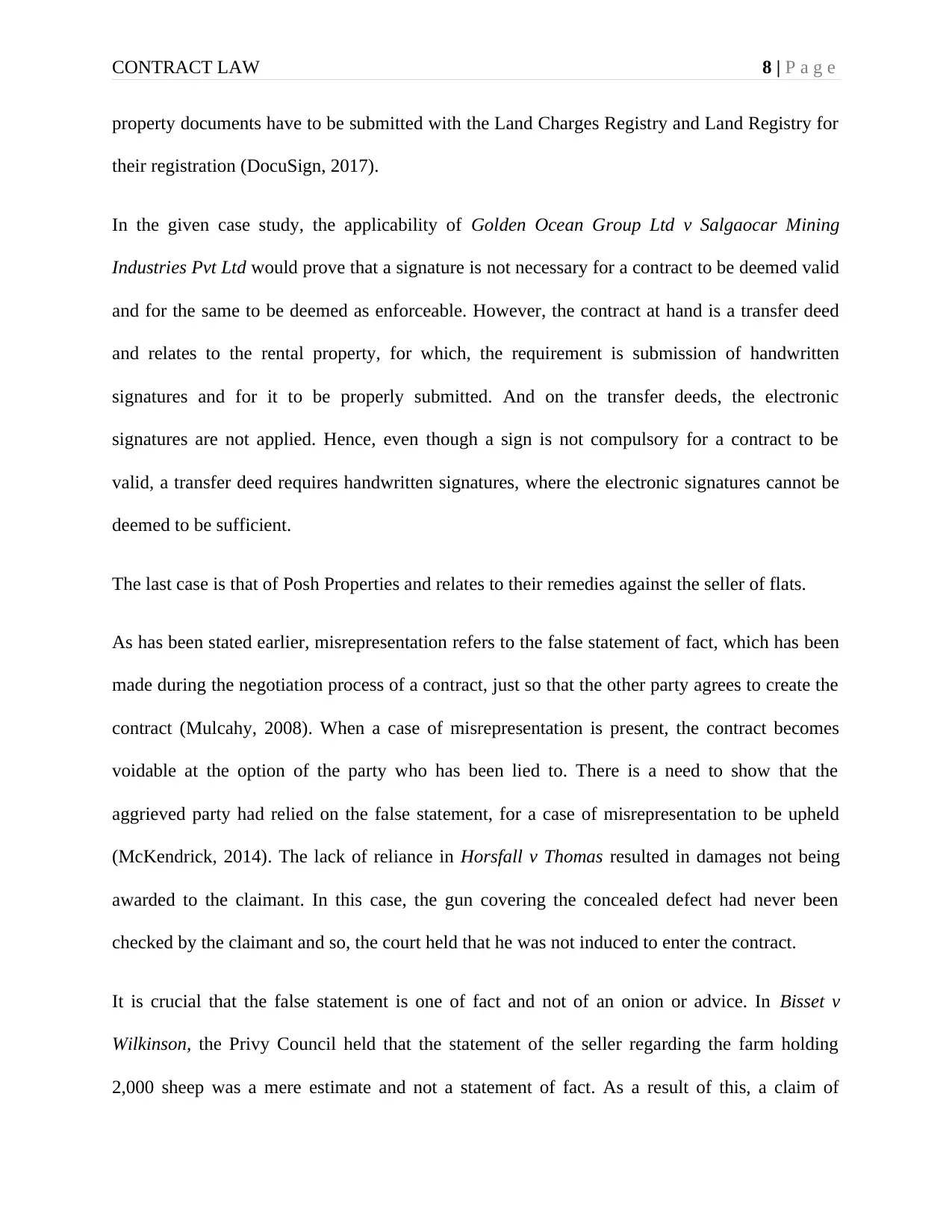
CONTRACT LAW 8 | P a g e
property documents have to be submitted with the Land Charges Registry and Land Registry for
their registration (DocuSign, 2017).
In the given case study, the applicability of Golden Ocean Group Ltd v Salgaocar Mining
Industries Pvt Ltd would prove that a signature is not necessary for a contract to be deemed valid
and for the same to be deemed as enforceable. However, the contract at hand is a transfer deed
and relates to the rental property, for which, the requirement is submission of handwritten
signatures and for it to be properly submitted. And on the transfer deeds, the electronic
signatures are not applied. Hence, even though a sign is not compulsory for a contract to be
valid, a transfer deed requires handwritten signatures, where the electronic signatures cannot be
deemed to be sufficient.
The last case is that of Posh Properties and relates to their remedies against the seller of flats.
As has been stated earlier, misrepresentation refers to the false statement of fact, which has been
made during the negotiation process of a contract, just so that the other party agrees to create the
contract (Mulcahy, 2008). When a case of misrepresentation is present, the contract becomes
voidable at the option of the party who has been lied to. There is a need to show that the
aggrieved party had relied on the false statement, for a case of misrepresentation to be upheld
(McKendrick, 2014). The lack of reliance in Horsfall v Thomas resulted in damages not being
awarded to the claimant. In this case, the gun covering the concealed defect had never been
checked by the claimant and so, the court held that he was not induced to enter the contract.
It is crucial that the false statement is one of fact and not of an onion or advice. In Bisset v
Wilkinson, the Privy Council held that the statement of the seller regarding the farm holding
2,000 sheep was a mere estimate and not a statement of fact. As a result of this, a claim of
property documents have to be submitted with the Land Charges Registry and Land Registry for
their registration (DocuSign, 2017).
In the given case study, the applicability of Golden Ocean Group Ltd v Salgaocar Mining
Industries Pvt Ltd would prove that a signature is not necessary for a contract to be deemed valid
and for the same to be deemed as enforceable. However, the contract at hand is a transfer deed
and relates to the rental property, for which, the requirement is submission of handwritten
signatures and for it to be properly submitted. And on the transfer deeds, the electronic
signatures are not applied. Hence, even though a sign is not compulsory for a contract to be
valid, a transfer deed requires handwritten signatures, where the electronic signatures cannot be
deemed to be sufficient.
The last case is that of Posh Properties and relates to their remedies against the seller of flats.
As has been stated earlier, misrepresentation refers to the false statement of fact, which has been
made during the negotiation process of a contract, just so that the other party agrees to create the
contract (Mulcahy, 2008). When a case of misrepresentation is present, the contract becomes
voidable at the option of the party who has been lied to. There is a need to show that the
aggrieved party had relied on the false statement, for a case of misrepresentation to be upheld
(McKendrick, 2014). The lack of reliance in Horsfall v Thomas resulted in damages not being
awarded to the claimant. In this case, the gun covering the concealed defect had never been
checked by the claimant and so, the court held that he was not induced to enter the contract.
It is crucial that the false statement is one of fact and not of an onion or advice. In Bisset v
Wilkinson, the Privy Council held that the statement of the seller regarding the farm holding
2,000 sheep was a mere estimate and not a statement of fact. As a result of this, a claim of
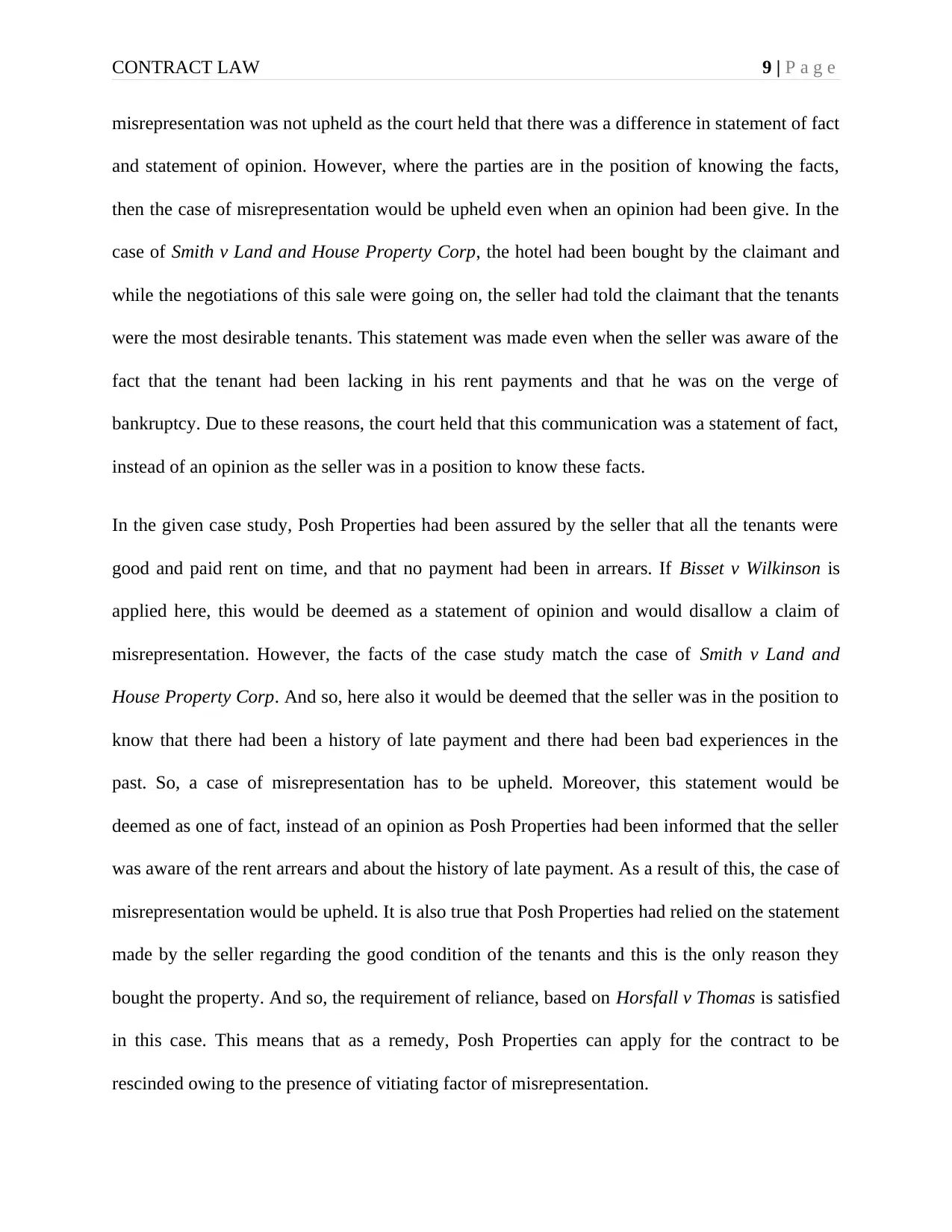
CONTRACT LAW 9 | P a g e
misrepresentation was not upheld as the court held that there was a difference in statement of fact
and statement of opinion. However, where the parties are in the position of knowing the facts,
then the case of misrepresentation would be upheld even when an opinion had been give. In the
case of Smith v Land and House Property Corp, the hotel had been bought by the claimant and
while the negotiations of this sale were going on, the seller had told the claimant that the tenants
were the most desirable tenants. This statement was made even when the seller was aware of the
fact that the tenant had been lacking in his rent payments and that he was on the verge of
bankruptcy. Due to these reasons, the court held that this communication was a statement of fact,
instead of an opinion as the seller was in a position to know these facts.
In the given case study, Posh Properties had been assured by the seller that all the tenants were
good and paid rent on time, and that no payment had been in arrears. If Bisset v Wilkinson is
applied here, this would be deemed as a statement of opinion and would disallow a claim of
misrepresentation. However, the facts of the case study match the case of Smith v Land and
House Property Corp. And so, here also it would be deemed that the seller was in the position to
know that there had been a history of late payment and there had been bad experiences in the
past. So, a case of misrepresentation has to be upheld. Moreover, this statement would be
deemed as one of fact, instead of an opinion as Posh Properties had been informed that the seller
was aware of the rent arrears and about the history of late payment. As a result of this, the case of
misrepresentation would be upheld. It is also true that Posh Properties had relied on the statement
made by the seller regarding the good condition of the tenants and this is the only reason they
bought the property. And so, the requirement of reliance, based on Horsfall v Thomas is satisfied
in this case. This means that as a remedy, Posh Properties can apply for the contract to be
rescinded owing to the presence of vitiating factor of misrepresentation.
misrepresentation was not upheld as the court held that there was a difference in statement of fact
and statement of opinion. However, where the parties are in the position of knowing the facts,
then the case of misrepresentation would be upheld even when an opinion had been give. In the
case of Smith v Land and House Property Corp, the hotel had been bought by the claimant and
while the negotiations of this sale were going on, the seller had told the claimant that the tenants
were the most desirable tenants. This statement was made even when the seller was aware of the
fact that the tenant had been lacking in his rent payments and that he was on the verge of
bankruptcy. Due to these reasons, the court held that this communication was a statement of fact,
instead of an opinion as the seller was in a position to know these facts.
In the given case study, Posh Properties had been assured by the seller that all the tenants were
good and paid rent on time, and that no payment had been in arrears. If Bisset v Wilkinson is
applied here, this would be deemed as a statement of opinion and would disallow a claim of
misrepresentation. However, the facts of the case study match the case of Smith v Land and
House Property Corp. And so, here also it would be deemed that the seller was in the position to
know that there had been a history of late payment and there had been bad experiences in the
past. So, a case of misrepresentation has to be upheld. Moreover, this statement would be
deemed as one of fact, instead of an opinion as Posh Properties had been informed that the seller
was aware of the rent arrears and about the history of late payment. As a result of this, the case of
misrepresentation would be upheld. It is also true that Posh Properties had relied on the statement
made by the seller regarding the good condition of the tenants and this is the only reason they
bought the property. And so, the requirement of reliance, based on Horsfall v Thomas is satisfied
in this case. This means that as a remedy, Posh Properties can apply for the contract to be
rescinded owing to the presence of vitiating factor of misrepresentation.
⊘ This is a preview!⊘
Do you want full access?
Subscribe today to unlock all pages.

Trusted by 1+ million students worldwide
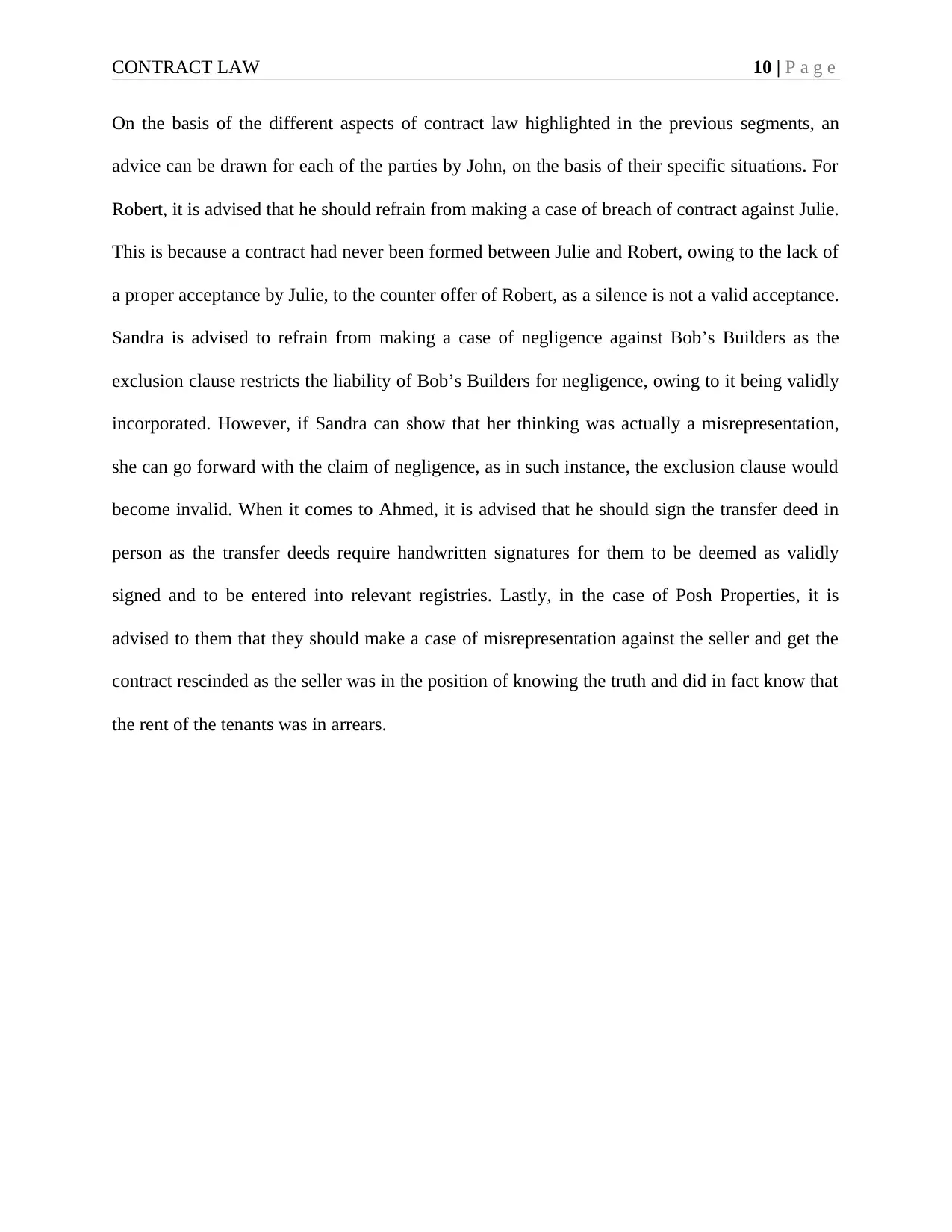
CONTRACT LAW 10 | P a g e
On the basis of the different aspects of contract law highlighted in the previous segments, an
advice can be drawn for each of the parties by John, on the basis of their specific situations. For
Robert, it is advised that he should refrain from making a case of breach of contract against Julie.
This is because a contract had never been formed between Julie and Robert, owing to the lack of
a proper acceptance by Julie, to the counter offer of Robert, as a silence is not a valid acceptance.
Sandra is advised to refrain from making a case of negligence against Bob’s Builders as the
exclusion clause restricts the liability of Bob’s Builders for negligence, owing to it being validly
incorporated. However, if Sandra can show that her thinking was actually a misrepresentation,
she can go forward with the claim of negligence, as in such instance, the exclusion clause would
become invalid. When it comes to Ahmed, it is advised that he should sign the transfer deed in
person as the transfer deeds require handwritten signatures for them to be deemed as validly
signed and to be entered into relevant registries. Lastly, in the case of Posh Properties, it is
advised to them that they should make a case of misrepresentation against the seller and get the
contract rescinded as the seller was in the position of knowing the truth and did in fact know that
the rent of the tenants was in arrears.
On the basis of the different aspects of contract law highlighted in the previous segments, an
advice can be drawn for each of the parties by John, on the basis of their specific situations. For
Robert, it is advised that he should refrain from making a case of breach of contract against Julie.
This is because a contract had never been formed between Julie and Robert, owing to the lack of
a proper acceptance by Julie, to the counter offer of Robert, as a silence is not a valid acceptance.
Sandra is advised to refrain from making a case of negligence against Bob’s Builders as the
exclusion clause restricts the liability of Bob’s Builders for negligence, owing to it being validly
incorporated. However, if Sandra can show that her thinking was actually a misrepresentation,
she can go forward with the claim of negligence, as in such instance, the exclusion clause would
become invalid. When it comes to Ahmed, it is advised that he should sign the transfer deed in
person as the transfer deeds require handwritten signatures for them to be deemed as validly
signed and to be entered into relevant registries. Lastly, in the case of Posh Properties, it is
advised to them that they should make a case of misrepresentation against the seller and get the
contract rescinded as the seller was in the position of knowing the truth and did in fact know that
the rent of the tenants was in arrears.
Paraphrase This Document
Need a fresh take? Get an instant paraphrase of this document with our AI Paraphraser

CONTRACT LAW 11 | P a g e
References
Andrews, N. (2015) Contract Law. 2nd ed. UK: Cambridge University Press
Ayres, I., and Klass, G. (2012) Studies in Contract Law. 8th ed. New York: Foundation Press
Bisset v Wilkinson [1927] AC 177
Blum, B.A. (2007) Contracts: Examples & Explanations. 4th ed. New York: Aspen Publishers.
Chappel & Co Ltd v Nestle Co Ltd [1960] AC 87
Clarke, P., and Clarke, J (2016) Contract Law: Commentaries, Cases and Perspectives. 3rd ed.
South Melbourne: Oxford University Press.
Curtis v Chemical Cleaning Co [1951] 1 KB 805
DocuSign. (2017) eSignature Legality Summary. [Online] DocuSign. Available from:
https://www.docusign.com/how-it-works/legality/global/the-united-kingdom [Accessed on:
27/10/17]
Donoghue v Stevenson [1932] AC 562
Elliot, C. (2011) Contract Law. 8th ed. London: Pearson.
Felthouse v Bindley (1862) EWHC CP J 35
Gibson, A., and Fraser, D. (2014) Business Law 2014. 8th ed. Melbourne, Pearson Education
Australia.
Golden Ocean Group Ltd v Salgaocar Mining Industries Pvt Ltd [2011] EWHC 56 (Comm)
References
Andrews, N. (2015) Contract Law. 2nd ed. UK: Cambridge University Press
Ayres, I., and Klass, G. (2012) Studies in Contract Law. 8th ed. New York: Foundation Press
Bisset v Wilkinson [1927] AC 177
Blum, B.A. (2007) Contracts: Examples & Explanations. 4th ed. New York: Aspen Publishers.
Chappel & Co Ltd v Nestle Co Ltd [1960] AC 87
Clarke, P., and Clarke, J (2016) Contract Law: Commentaries, Cases and Perspectives. 3rd ed.
South Melbourne: Oxford University Press.
Curtis v Chemical Cleaning Co [1951] 1 KB 805
DocuSign. (2017) eSignature Legality Summary. [Online] DocuSign. Available from:
https://www.docusign.com/how-it-works/legality/global/the-united-kingdom [Accessed on:
27/10/17]
Donoghue v Stevenson [1932] AC 562
Elliot, C. (2011) Contract Law. 8th ed. London: Pearson.
Felthouse v Bindley (1862) EWHC CP J 35
Gibson, A., and Fraser, D. (2014) Business Law 2014. 8th ed. Melbourne, Pearson Education
Australia.
Golden Ocean Group Ltd v Salgaocar Mining Industries Pvt Ltd [2011] EWHC 56 (Comm)
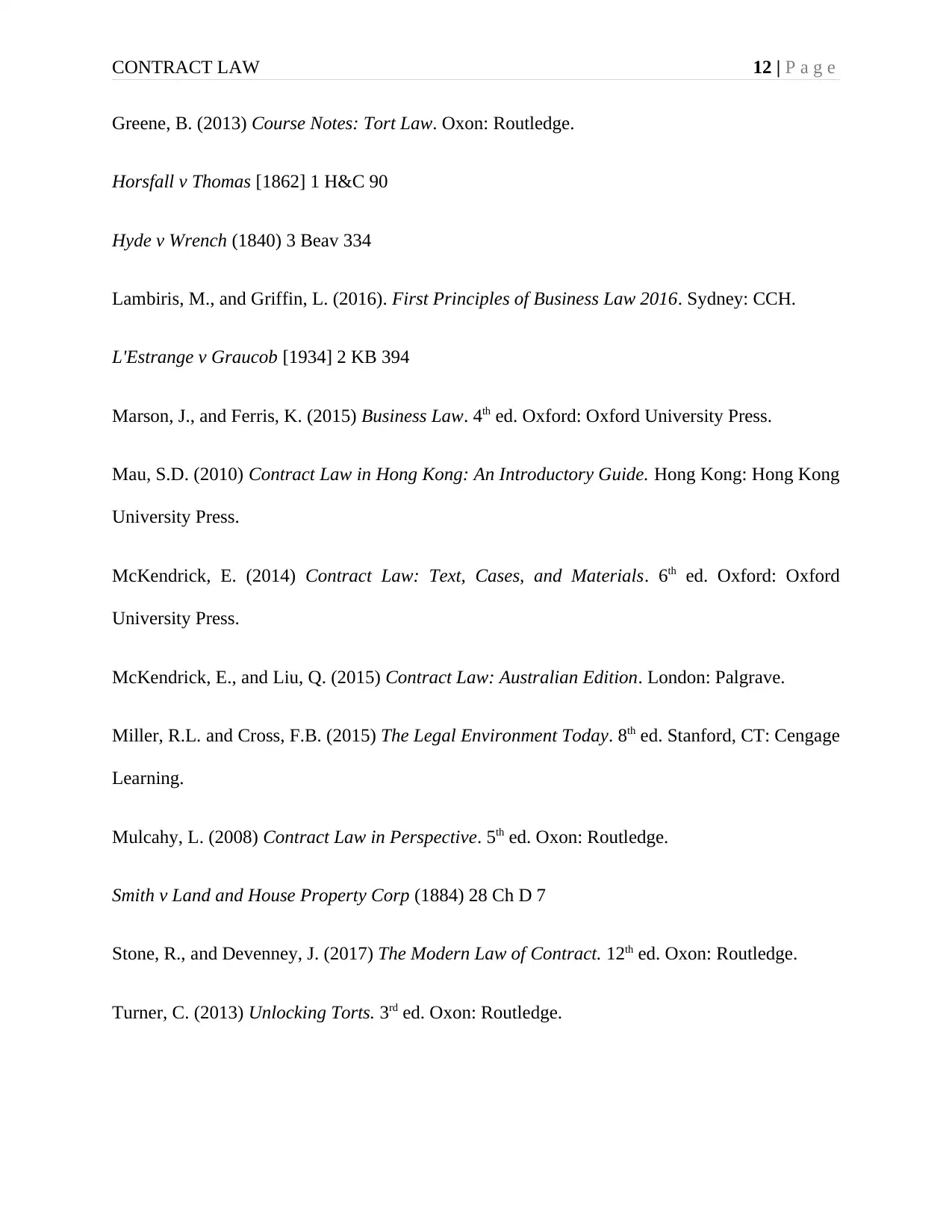
CONTRACT LAW 12 | P a g e
Greene, B. (2013) Course Notes: Tort Law. Oxon: Routledge.
Horsfall v Thomas [1862] 1 H&C 90
Hyde v Wrench (1840) 3 Beav 334
Lambiris, M., and Griffin, L. (2016). First Principles of Business Law 2016. Sydney: CCH.
L'Estrange v Graucob [1934] 2 KB 394
Marson, J., and Ferris, K. (2015) Business Law. 4th ed. Oxford: Oxford University Press.
Mau, S.D. (2010) Contract Law in Hong Kong: An Introductory Guide. Hong Kong: Hong Kong
University Press.
McKendrick, E. (2014) Contract Law: Text, Cases, and Materials. 6th ed. Oxford: Oxford
University Press.
McKendrick, E., and Liu, Q. (2015) Contract Law: Australian Edition. London: Palgrave.
Miller, R.L. and Cross, F.B. (2015) The Legal Environment Today. 8th ed. Stanford, CT: Cengage
Learning.
Mulcahy, L. (2008) Contract Law in Perspective. 5th ed. Oxon: Routledge.
Smith v Land and House Property Corp (1884) 28 Ch D 7
Stone, R., and Devenney, J. (2017) The Modern Law of Contract. 12th ed. Oxon: Routledge.
Turner, C. (2013) Unlocking Torts. 3rd ed. Oxon: Routledge.
Greene, B. (2013) Course Notes: Tort Law. Oxon: Routledge.
Horsfall v Thomas [1862] 1 H&C 90
Hyde v Wrench (1840) 3 Beav 334
Lambiris, M., and Griffin, L. (2016). First Principles of Business Law 2016. Sydney: CCH.
L'Estrange v Graucob [1934] 2 KB 394
Marson, J., and Ferris, K. (2015) Business Law. 4th ed. Oxford: Oxford University Press.
Mau, S.D. (2010) Contract Law in Hong Kong: An Introductory Guide. Hong Kong: Hong Kong
University Press.
McKendrick, E. (2014) Contract Law: Text, Cases, and Materials. 6th ed. Oxford: Oxford
University Press.
McKendrick, E., and Liu, Q. (2015) Contract Law: Australian Edition. London: Palgrave.
Miller, R.L. and Cross, F.B. (2015) The Legal Environment Today. 8th ed. Stanford, CT: Cengage
Learning.
Mulcahy, L. (2008) Contract Law in Perspective. 5th ed. Oxon: Routledge.
Smith v Land and House Property Corp (1884) 28 Ch D 7
Stone, R., and Devenney, J. (2017) The Modern Law of Contract. 12th ed. Oxon: Routledge.
Turner, C. (2013) Unlocking Torts. 3rd ed. Oxon: Routledge.
⊘ This is a preview!⊘
Do you want full access?
Subscribe today to unlock all pages.

Trusted by 1+ million students worldwide
1 out of 15
Related Documents
Your All-in-One AI-Powered Toolkit for Academic Success.
+13062052269
info@desklib.com
Available 24*7 on WhatsApp / Email
![[object Object]](/_next/static/media/star-bottom.7253800d.svg)
Unlock your academic potential
Copyright © 2020–2025 A2Z Services. All Rights Reserved. Developed and managed by ZUCOL.





